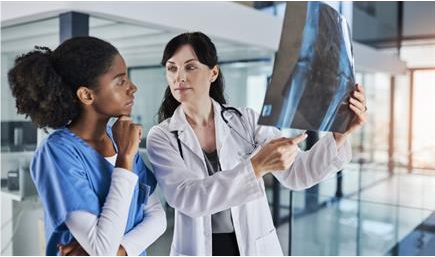Our Doctors
Meet all the doctors from Cleveland Clinic Abu Dhabi.
View Doctors
We take a look at the benefits of X-ray imaging versus the potential risk

X-rays are used when a doctor needs to get an accurate picture of what is happening inside your body. They are quick, painless procedures that use radiation technology to obtain the images. As well being used to see broken bones, they can detect and diagnose a whole range of medical conditions.
As X-rays expose us to radiation, people often worry about the harm that this exposure may cause. We explore exactly how much of a risk is involved in getting an X-ray, and how the benefits far outweigh these concerns.
X-rays have been widely used in medicine for a long time - over 100 years in fact. Most of us will have had an X-ray at some point in our lives, either when we think we may have broken a bone or at the dentist.
A standard X-ray image is obtained by placing a part of the body in front of the X-ray machine and firing short pulses at it. The radiation passes through muscle, fat and skin easily, but your bones absorb it as it is much denser. This then appears as white on the image that is produced, in contrast to the less dense tissue that appears dark.
The most frequently used X-rays are:
Radiation occurs naturally all around us. We are exposed to it on a daily basis at very low levels. But, in high enough doses, it can cause a change in our cell’s DNA, which might lead to an increased risk of cancer later in life. While X-rays do expose us to radiation, the levels are extremely low, and the benefits far outweigh any potential risks. If suitable, you will be given protective clothing to wear to minimize the amount of radiation that comes into contact with other parts of your body. For example, if you are having an X-ray taken of your arm, a led apron should be worn which stops the radiation from reaching other areas. If you are pregnant, you must always let your doctor know before you enter the X-ray department, as radiation may be harmful to your baby.
To put it in context, it is useful to compare the amount of radiation we receive from an X-ray with the normal radiation levels that surround us naturally. For example, every time we take a long-haul flight, we are exposed to three times the amount of radiation that a chest-X-ray produces. Receiving an X-ray for a broken bone is equivalent to the amount of naturally occurring background X-ray that we are exposed to.
The type of medical image we are receiving will affect the amount of radiation we are exposed to. For example, a CT scan delivers a higher dose than a regular X-ray as it takes many more images, so the number of scans you receive will always be carefully assessed by your doctor.
As imaging using radiation can give doctors an exact picture of what is going on inside your body, they are a crucial part of the diagnostic process. When coupled with things like blood tests and physical examinations, they help doctors to quickly and accurately find out what is wrong and provide you with the most appropriate treatment. They also sometimes lead to unexpected discoveries, when a patient is being screened for something else entirely.
As well as providing pictures of your body for diagnostic purposes, X-rays can help doctors during medical procedures, and guide them as they perform life-saving surgery.
It is important to always consider the benefits when having an X-ray, so talk to your doctor and radiographer if you have any concerns. Thanks to the advancements in imaging technology, we are now able to quickly and accurately diagnose more medical conditions than ever before, meaning we are living longer and healthier lives.